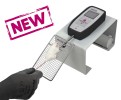Authors
F. E. Mackenzie, A. Parker, N. J. Parkinson, P. L. Oliver, D. Brooker et al.
Lab
MRC Mammalian Genetics Unit, Harwell, U.K.
Journal
Genes, Brain and Behavior
Abstract
Deafness is the most common sensory disorder in humans and the aetiology of genetic deafness is complex. Mouse mutants have been crucial in identifying genes involved in hearing. However, many deafness genes remain unidentified. Using N-ethyl N_nitrosourea (ENU) mutagenesis to generate new mouse models of deafness, we identified a novel semi-dominant mouse mutant, Cloth-ears (Clth). Cloth-ears mice show reduced acoustic startle response and mild hearing loss from _30 days old. Auditory-evoked brainstem response (ABR) and distortion product otoacoustic emission (DPOAE) analyses indicate that the peripheral neural auditory pathway is impaired in Cloth-ears mice, but that cochlear function is normal. In addition, both Clth/Clth and Clth/+ mice display paroxysmal tremor episodes with behavioural arrest. Clth/Clth mice also show a milder continuous tremor during movement and rest. Longitudinal phenotypic analysis showed that Clth/+ and Clth/Clth mice also have complex defects in behaviour, growth, neurological and motor function. Positional cloning of Cloth-ears identified a point mutation in the neuronal voltage-gated sodium channel _-subunit gene, Scn8a, causing an aspartic acid to valine (D981V) change six amino acids downstream of the sixth transmembrane segment of the second domain (D2S6). Complementation testing with a known Scn8a mouse mutant confirmed that this mutation is responsible for the Cloth-ears phenotype. Our findings suggest a novel role for Scn8a in peripheral neural hearing loss and paroxysmal motor dysfunction.
BIOSEB Instruments Used:
Grip strength test (BIO-GS3)

 Pain - Thermal Allodynia / Hyperalgesia
Pain - Thermal Allodynia / Hyperalgesia Pain - Spontaneous Pain - Postural Deficit
Pain - Spontaneous Pain - Postural Deficit Pain - Mechanical Allodynia / Hyperalgesia
Pain - Mechanical Allodynia / Hyperalgesia Learning/Memory - Attention - Addiction
Learning/Memory - Attention - Addiction Physiology & Respiratory Research
Physiology & Respiratory Research
 Pain
Pain Central Nervous System (CNS)
Central Nervous System (CNS) Neurodegeneration
Neurodegeneration Sensory system
Sensory system Motor control
Motor control Mood Disorders
Mood Disorders Other disorders
Other disorders Muscular system
Muscular system Joints
Joints Metabolism
Metabolism Cross-disciplinary subjects
Cross-disciplinary subjects Happy new year 2025
Happy new year 2025 